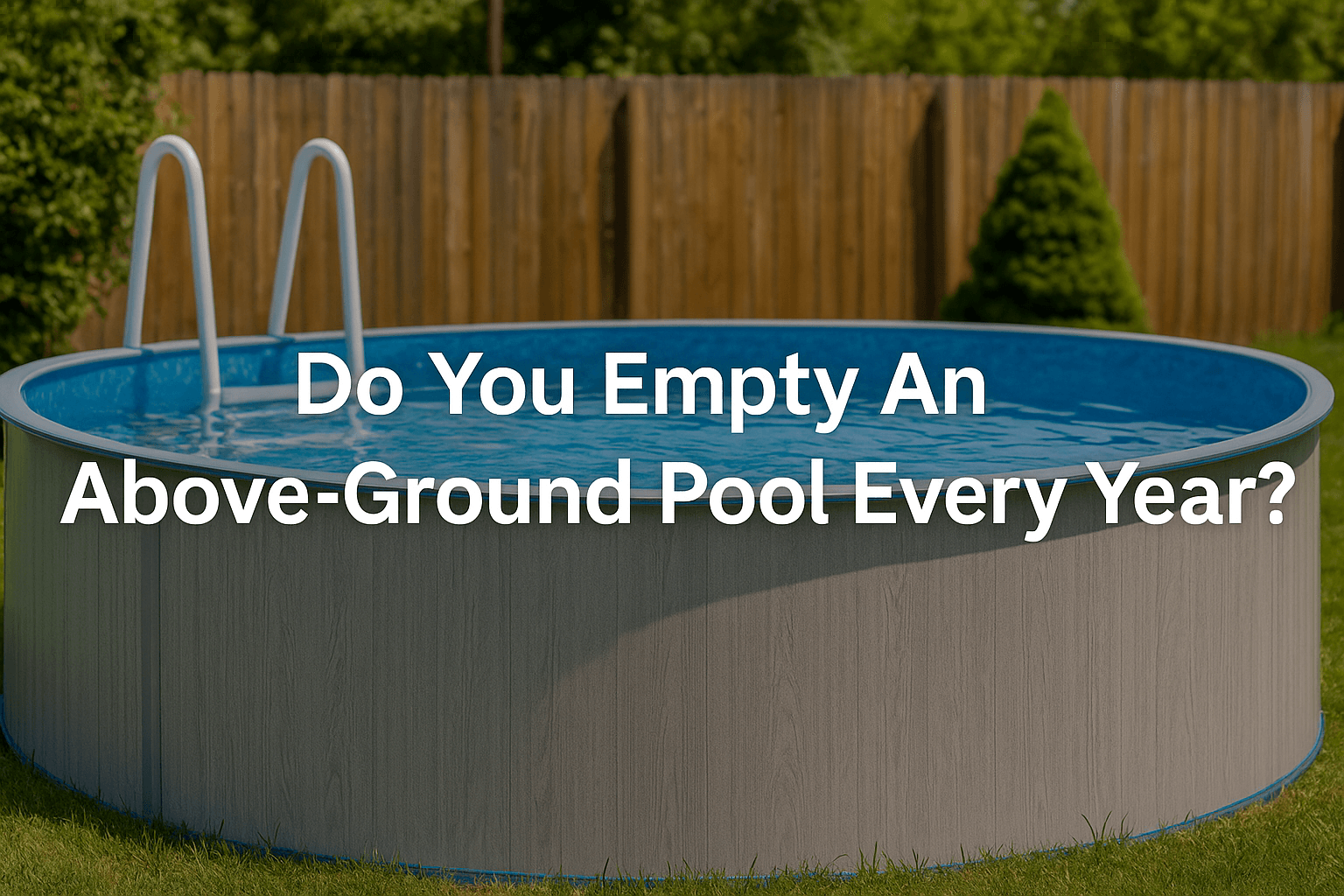
Do You Empty An Above-Ground Pool Every Year?
Draining your above-ground pool every year? Thankfully, no—unless you enjoy wasting water and wrestling liners. The best above ground pools just need smart care, not a full empty. Here’s when to drain, when not to, and how to keep things splash-ready all year.
Why Annual Draining is Generally Not Recommended
Draining the whole pool every year might sound like a good clean start. But in reality? It’s often a fast track to more problems than it solves.
Think of it like taking all the tyres off your car just to check the pressure.
Protecting the Pool's Structural Integrity
Water Pressure Keeps Walls and Liner Stable
Your pool relies on water to hold its shape.
Without that internal pressure, the walls can start to cave in — especially if you’ve had a lot of rain or the ground shifts. It’s like removing the jelly from a jelly mould… everything collapses.
Risk of Liner Shrinkage, Cracking, or Shifting
Leave a liner dry for too long and it might not go back the way it came.
They’re flexible when warm and wet — but if they dry out, they can become brittle, shrink, or crack. And replacing a liner isn’t cheap or easy.
Potential Damage to the Pool Base and Leveling
An empty pool exposes the base to the elements.
Heavy rain? The ground underneath can shift. Frost? You might get heaving and lumps next spring.
Once the level's off, it’s game over for even water circulation and good filtration.
Unnecessary Stress on Pool Components (During Refilling)
Filling from scratch puts pressure on all the pool’s working parts.
Filters, liners, seams — they’re built to handle water, but sudden changes in weight and pressure can lead to leaks or mechanical faults.

The Environmental and Cost Impact of Full Drains
Wasting Large Volumes of Water
Most above-ground pools hold between 7,000 and 20,000 litres.
Dumping that every year? That’s enough water to fill a hot tub 30 times or take 250 showers.
Increased Water Bills
And unless you’re on a flat water rate, your next bill won’t be a fun read.
Filling a pool from scratch costs more than most people think — especially if you’re doing it during a heatwave when prices can spike.
Chemical Costs for Re-balancing New Water
Fresh tap water isn’t swim-ready.
You’ll need chlorine, stabiliser, pH adjusters, and maybe even algaecide just to get it balanced. That adds up quickly — both in time and money.

When Partial Draining or Full Draining is Necessary
Common Reasons for Partial Draining
Sometimes you don’t need to go all the way. Just a top-up or a partial drain can do the trick — no need to pull the plug completely.
Winterisation (Lowering Water Below Skimmer/Returns)
In the UK, winterising your pool means lowering the water below the return jets and skimmer.
It helps prevent freeze damage to hoses and fittings, especially during long cold snaps. Just remember to cover it well — squirrels love an open pool cover.
Addressing Specific Chemical Imbalances (e.g., High TDS, Cyanuric Acid)
If your stabiliser levels (cyanuric acid) or total dissolved solids (TDS) get too high, a partial drain can help.
Think of it like topping up soup with water when it gets too salty. You don’t throw it out — just balance it out.
Performing Minor Repairs Below the Waterline
Got a small liner tear or need to swap a gasket? Drop the waterline just below the problem and crack on.
No need to go full drain unless the issue’s more serious.
Specific Situations That May Require a Full Drain
There are a few times when a full drain makes sense — but they’re rare and usually tied to major work.
Liner Replacement (Only When Preparing for New Liner Installation)
This is the big one. If your liner’s had it — faded, cracked, or coming off the walls — draining is essential.
But only do this when you're ready to install the new one right away. Empty pools don’t like waiting around.
Major Structural Repairs or Relocation of the Pool
Moving the pool? Rebuilding a crushed wall? Yeah, you’ll need it empty.
Make sure the area is level and prepped before refilling — no one wants to realise it’s wonky once it's full.
Extreme Water Contamination Beyond Chemical Correction
Sometimes, water gets so bad that nothing will save it — think sludge, dead frogs, or a winter cover that flew off unnoticed.
In that case, draining and starting over is the cleanest, safest option.

Important Precautions When Draining
If you do need to drain your pool, timing and technique matter. One wrong move and you could damage the very thing you’re trying to protect.
Only Drain When Temperatures Are Not Extreme (Warm Day for Liner Elasticity)
Avoid draining during heatwaves or frosty mornings. The liner needs to stay stretchy.
Warm but mild days are perfect — not too hot, not too cold.
Refill Immediately After Repairs or Liner Installation
Once the job’s done, get that pool filled again — fast.
An empty shell is a sitting duck for wind damage, UV exposure, and warping.
Following Manufacturer Guidelines for Draining Procedures
Always check the manual. Some brands will void your warranty if you drain without following their steps.
Intex, Bestway and other top names often have special instructions to protect the liner and frame.
Checking Local Regulations for Water Disposal
Lastly, don’t just dump it down the street. Local councils often have rules about where you can release pool water.
It’s not just water — it may contain chlorine or algaecide that can harm local drains or gardens.
Final Word?
Don’t drain unless you really need to. Keep your water healthy, maintain your pool regularly, and you’ll avoid the big jobs altogether.
A little weekly care = fewer headaches, smaller bills, and more sunny splashes with the family.
Let your pool work with you — not against you.
Have you checked out our other posts?
Will Above Ground Pool Freeze?
Can You Leave Above Ground Pools Up In The Winter?
Do You Drain Above Ground Pools In The Winter?



Leave a comment